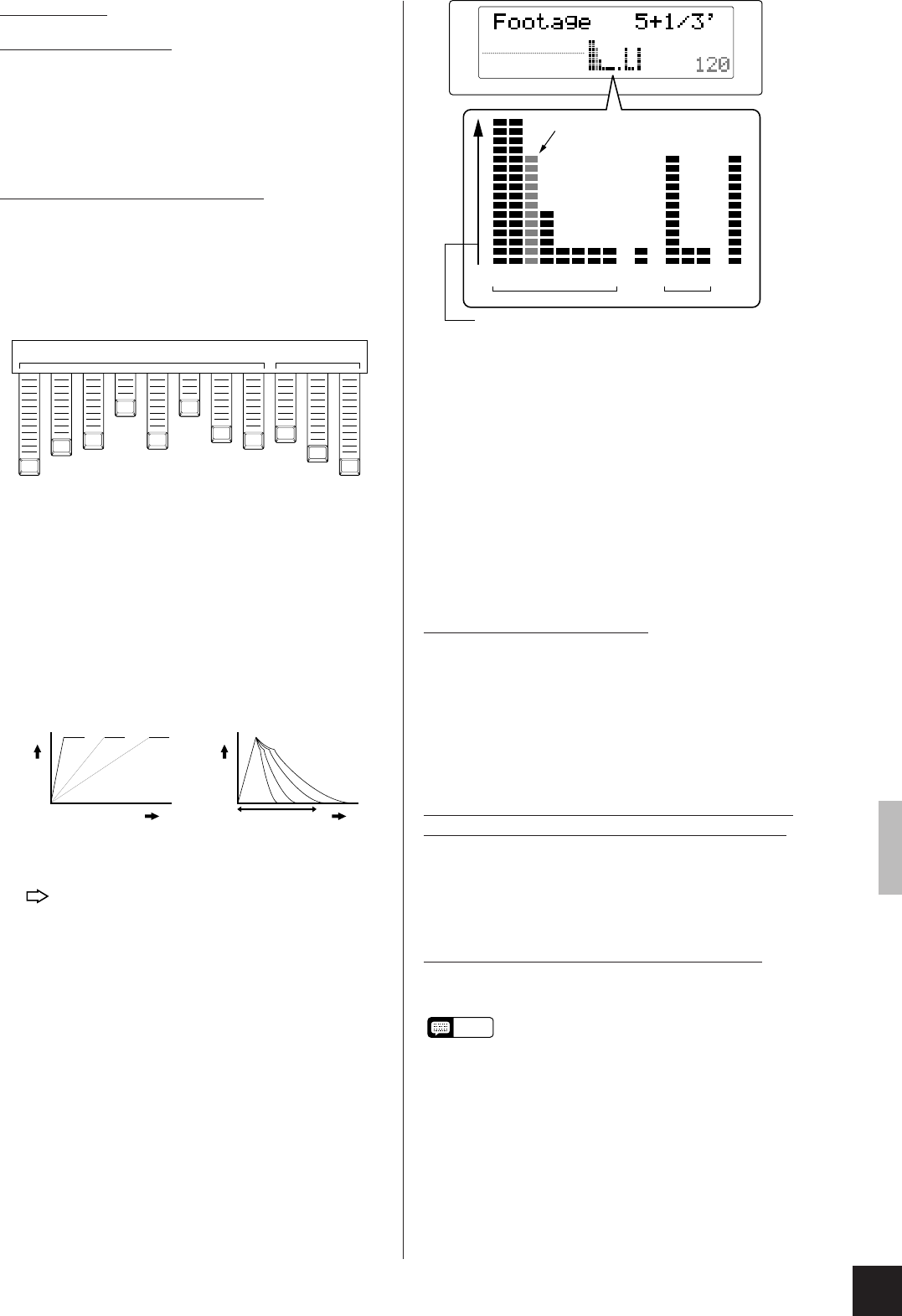
31
CLP-811/611 Configuration Functions (FUNCTION mode)
Subfunctions
6.1 ****** (Organ type) [ Where “******” is replaced by
the type name, such as “JAZZ ORGAN1”. If the selected
type has been edited, a “*” appears after the name.]
Values: JAZZ ORGAN1, JAZZ ORGAN2, JAZZ OR-
GAN3, JAZZ 16 '1', BASIC 16 '8', THEATER 16',
OLD ORGAN, WONDERFUL
Default: JAZZ ORGAN1
6.2 VoiceEdit (Voice edit settings)
Each voice allows you to set independent volumes for eight
continuous tones and three decaying attack tones. You can also
set a response time (for the continuous tones) and an attack
length (for the decay tones).
Tones and Volumes
• The 8-foot stop sets the volume for the fundamental tone.
The 4-foot, 2-foot, and 1-foot stops respectively set volumes
for the overtones that are one octave, two octaves, and three
octaves up. The 16-foot stop sets the volume for the tone that
is one octave lower than the fundamental tone.
Response Time and Attack Length
Procedure
1 Go to the [6.2 VoiceEdit] screen, and then press SONG
SELECT [▼] or [▲] to move into the editing component.
The screen displays a bar graph. Each bar corre-
sponds to a different parameter, and can be set to any
of eight levels.
2 You can now use SONG SELECT [▼], [▲] to move from
bar to bar, and the [+/YES] and [-NO] buttons to change
the bar levels. The currently selected bar is displayed in
blinking mode.
3 When you are finished editing, you can press [t] or [s]
to move to another subfunction.
Edit parameters are as follows.
Footage 16' (Continuous-tone volume)
Footage 8' (Continuous-tone volume)
Footage 5+1/3' (Continuous-tone volume)
Footage 4' (Continuous-tone volume)
Footage 2+2/3' (Continuous-tone volume)
Footage 2' (Continuous-tone volume)
Footage 1+1/3' (Continuous-tone volume)
Footage 1' (Continuous-tone volume)
Response (Response time for continuous tones)
AtkFootage 4' (Decay-tone)
AtkFootage 2+2/3' (Decay-tone)
AtkFootage 2' (Decay-tone)
AtkLength (Length of decay tones)
6.3 AtkMode (Attack mode)
This parameter sets the attack mode for the organ voice
selected by subfunction 6.1. Choose either of the following.
EACH: Apply attack tones to all notes. (This is the
default.)
FIRST: Apply attack tones only to the first held note of
any note combination (legato sequence). If at
least one key is down, all subsequent keys are
produced without attack tones.
6.4 RotSP.Spd (Speed of rotary-speaker effect)
6.5 RotSP.Dpt (Depth of rotary-speaker effect)
Values: 0,...,20
Default: Varies according to organ type
These parameters set up the rotary-speaker effect. The speed
setting selects the speaker’s rotation speed. The depth setting
selects the intensity of the effect.
6.6 ResetOK? (Return to factory defaults.)
Press [+/YES] to return all of the edit settings for the selected
voice type to their factory defaults.
NOTE
As a shortcut, you can switch directly into
FUNCTION mode’s F6.OrganEdit area by
holding down the [ORGAN COMBINATION]
button and pressing [FUNCTION]. When you
are ready to exit from FUNCTION mode, press
[FUNCTION] once again.
BRILLIANCE
REVERB
NORMAL
ROOM
EFFECT TOUCH
MEDIUM
TEMPO
16'
8'
5+1/3'
4'
2+2/3' 2+2/3'
Footage
Response AtkLength
2'
1+1/3'
1'
4' 2'
AtkFootage
Each parameter (each bar on the graphic) can be set to any of eight levels.
Selected bar flashes on and off.
16'
8'
5+
1
/
3
'
4'
2+
2
/
3
'
2'
1+
1
/
3
'
1'
4'
2+
2
/
3
'
2'
Continuous tones Decay tones
4-foot
2+2/3-foot
2-foot
4-foot
2+2/3-foot
2-foot
1+1/3-foot
1-foot
16-foot
8-foot
5+1/3-foot
Volume
Time
Attack length
Longer attack length →
Greater response time →
Volume
Time
Continuous Tone Decay Tone


















